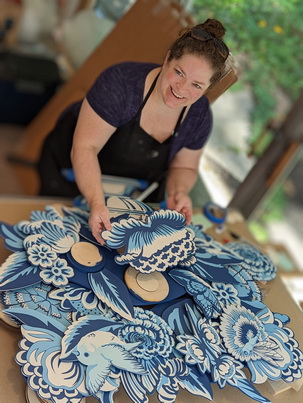 |
Janice Jakielski | |
| Birth Date: b. |
||
Artist Gallery |
||
| Janice Jakielski is a Colorado based ceramicist and sculptor. Raised in rural Pennsylvania amongst a large Amish population, Jakielski had unrestricted access to tools and grew up with a creative and innovative outlook, as well as an affinity for constant experimentation. According to her, this hands-on approach to childhood “set the foundation for a love of all materials and the magical transformations that they could undergo.”
Jakielski received her undergraduate degree from Alfred University in New York, and her master’s degree from the University of Colorado, Boulder. The creative experimentation from her childhood has inspired her artistic process into adulthood. She has experimented with many creative pursuits, including glass-blowing and textiles, though she is especially drawn to ceramics. She said, “I gather skills and material knowledge as an obsession, perfecting craftsmanship and blending processes as my practice evolves and grows.” She finds the creative possibilities of ceramics endless, and has even created a niche for herself within the broad scope of the medium through inventing new ways of casting and manipulating ultra-thin porcelain sheets, transforming them into objects that challenge conventional perceptions.
Jakielski’s process is incredibly time-consuming and involves tedious stages of design and development. She says, “By inventing a new way of casting and manipulating ultra-thin porcelain sheets I am able to create impossible objects.” Her experimental techniques are in part inspired by her husband, who is an engineer at a ceramic technology company. She is drawn to adapting these industrial processes for artistic uses. The majority of her work uses the tape-casting technique, which is a process traditionally used in the microelectronics industry to make thin ceramic sheets. Her patent-pending process includes mixing clay with binders and plasticizers, like Elmer’s glue. The combination is then squeezed onto sheets of plastic, left to set, and when Jakielski is ready to use it, she peels it off. It is clay with a paper quality—incredibly flexible and thin—and remains workable over a long period of time. In the firing, the non-clay materials fire out, leaving only the porcelain behind. This process results in extremely thin porcelain strips that Jakielski then molds and shapes to create her detailed ceramic forms. The material fragility of the medium requires Jakielski to be hyper-focused on her every movement, deliberate and present in the moment.
Jakielski’s inspiration is drawn from historic ceramic vessels. Through using her own techniques, she reimagines these historic objects in ways not feasible using traditional ceramics. According to her, “Most recently I have been expanding and challenging the notion of what clay is. Taking cues from industry I have begun adapting and inventing new ways for working with this most ancient material. From tape casting to foaming to gelling, my time in the laboratory is truly experimental, each new discovery brings a wave of possibility and excitement.” The resulting objects combine both the historic and contemporary, bringing together new technologies with the traditional hand of the maker. Jakielski continues to push the boundaries of clay, constantly experimenting with new techniques and ideas.
Jakielski has exhibited both nationally and internationally, including the Houston Center for Contemporary Crafts, Houston, TX, The Society of Art and Craft, Boston, MA, Cross MacKenzie Gallery, Washington DC and Racine Art Museum, MO, among others. She has participated in numerous residencies such as the Archie Bray Foundation, Roswell Artist in Residency, Djerassi and Millay Colony for the Arts. She is a recipient of a 2019 Mass Cultural Council Artist Fellowship and former Instructor of Ceramics at Harvard University.
|
||


